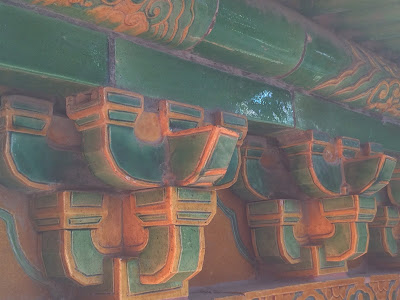
It's travel time again at Words and Pictures today.
Normal crafty service will be resumed shortly - and it will be full creative steam ahead for a few days at that point. But we're heading for Chinese craft supplies today!
There's no denying the Forbidden City was awe-inspiring and deeply impressive (catch Part I, Part II and Part III - the Emperor's private gardens, if you missed them) but my favourite place in Beijing was undoubtedly Liulichang - a long street (nearly a kilometre) full of shops selling calligraphy materials and other artsy supplies and artefacts.

And I do mean "full" - there are no other kinds of shops at all, barring the odd art gallery or glazing factory. It's all arts and calligraphy supplies.
The stores range from huge emporia...

... brilliantly decorated...

... to tiny little one room huts, packed to the rafters (and I do mean to the rafters) with brushes, ink stones, seals and wax.
I'm lucky in that my Danish aunt's brother is living with his family in Beijing at the moment When his wife, Bettina, asked what I'd be interested in seeing, the answer was simple - art/calligraphy supplies and demonstrations, if possible.
On arrival in Beijing I had a quick shower and set out straight away to meet up with her. (By the end of the day I'd gone 30 hours without sleep, but it was worth it!)

Fortunately, she's of a similar artistic mindset and was more than happy to spend several hours wandering in and out of endless stores comparing prices on brushes, brush stands, ink stones and rice paper.
As well as the art shops, we also stepped in to see inside some hutongs - the traditional alleyway dwellings of which there are just a few left in Beijing. It didn't feel right taking photos of private homes, so I don't have pictures.
 But if you imagine this courtyard with five or six small houses built inside it, housing up to eight families, you'll have some idea of how the hutongs work.
But if you imagine this courtyard with five or six small houses built inside it, housing up to eight families, you'll have some idea of how the hutongs work. Liulichang is crossed by a main road at one point - this is the decorative footbridge which delivers you to the other side to continue your artsy journey.

In one of the larger shops, there was a tiny studio out back where at several desks, back to back, at least seven craftsmen and women were busy making brushes. It was incredible to see them in action, so we asked whether it would be okay to take some photos.

The first man was taking the soaked animal hair and shaping it into the brush heads. His hands were moving so fast you couldn't get a photo without them blurring.

The next man was holding fine twine between his teeth and using his hands to wrap it around the base of the brush heads to hold the bristles in place, several heads at a time to one piece of twine.
To his right was a man sorting them into sizes and the two women behind were fixing them into the handles - some of wood, some bamboo.

At the final stage, this man was adding calligraphy to the handles - sometimes carving it in, sometimes inking with gold or black ink.
Astonishing speed and dexterity from every single one of them to churn out brushes by the hundred.

I'm sure you're wondering whether, with all those riches and that crafsmanship on display, I bought anything...
Well, I knew before I went that I wanted one of the large size brushes if it was affordable, and thanks to some excellent haggling by Bettina I came away with rather more than that.

I have a large bundle of rice paper and a rather beautiful linen covered album. Rather than separate pages, the whole thing opens out as a wonderful accordion (several metres long), so I'll have to come up with a way to make the most of that.

The white headed brushes are made of goat's hair (the large one's bristles are 4.5 inches long and nearly 2 inches in diameter), and the brown ones are wolf's hair (from the tails, as far as I can make out).

Inside the silk-covered box is a trio of exquisitely fine-headed rabbit hair brushes. And the whole lot came in for around the £30 mark. Colour me happy! I only wish I'd bought a stand to hang them from too, as Bettina did. Ah well... next time (I'm kidding!!).
Thank you for dropping in. I hope you've enjoyed this little artistic detour as much as I did. One of these days, I may even get to try out my beautiful Chinese brushes. Next stop (some time)... Shanghai, but first there will be some new crafty creations to share with you. Watch this space!
Calligraphy may well be simply an artistic version of another form, that is the ideograms which make up the poem, but then not only does it reflect the character and temperament of the artist but . . . also betrays his heart rate, his breathing.
From Once on a Moonlit Night by Dai Sijie












































